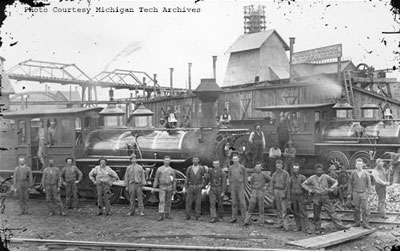|
Historians and the general public often underestimate the importance of Michigan’s Upper Peninsula mining industries in the development of Michigan and the Lake Superior basin. Much of the best historical resource material on this aspect of state history is held by smaller organizations and institutions in this geographically-remote area of the state. This project is designed to create web resources to familiarize users with the history of Michigan’s Copper Country and help them explore the complex community of ethnic and cultural backgrounds attracted to this urban outpost along the shores of Lake Superior.
Pre-automobile Michigan had very little ethnic diversity. The Erie Canal and Great Lakes seaway attracted early settlers primarily from New England. Agriculture dominated the economy of early “Yankee” Michigan, drawing few immigrants and even fewer from eastern and southern Europe. The exception to this Yankee Michigan was its Upper Peninsula and, more specifically, the Keweenaw Peninsula. The Keweenaw became the center of the nation’s first capital-intensive mining boom in the mid-Nineteenth Century, propelling Michigan’s Copper Country to international fame and attracting the hopes and dreams of thousands of ethnic immigrants. The 1870 Federal Census reveals that Houghton County, with 56.6 percent of its population foreign-born, had the third largest percentage of foreign-born population in the United States. While in that year 71 percent of Americans had native-born parents, less than 5 percent of Houghton County residents could make such a claim. More than 95 percent of all Houghton County residents had at least one parent of foreign birth, the greatest such percentage in the entire United States.
The peopling of Michigan’s Copper Country, like all migration, was an economic process. People were pushed out of areas that experienced high levels of surplus labor and pulled to areas that experienced labor shortages. This project explores the “push-pull” mechanism of migration by examining the economic factors that pushed migrants out of various parts of the world and other factors that pulled them to the Keweenaw. It also details the peninsula’s numerous ethnic groups and examines how changing economic factors affected this ethnic composition. Initially, for instance, the peninsula drew its labor chiefly from the British Isles, Western Europe and Canada, then, after 1880, largely from southern and eastern Europe. Yet by 1910, Finns, Italians, and immigrants from Western Europe dominated its foreign-born population. Indeed, as late as 1910, Houghton County had Michigan’s largest Chinese population and the Calumet public schools claimed to have enrolled children of 40 different nationalities.
Ethnicity is first and foremost a relationship, and this project explores how various immigrant groups interacted with each other and the larger American society, and how their cultures shaped the larger culture of Michigan’s Copper Country. Particular attention is given to the immigrant experience and how ethnic groups experienced the often-conflicting process of “Americanization” and the pressure of Anglo-conformity while simultaneously struggling to retain their ethnic identity. This process is illustrated in the Keweenaw through many photographs of immigrant groups in stereotype native costume, or marching with ethnic-based organizations carrying the omnipresent American flag. Difference can often be clarified through cultural tags – language, music, dress, cuisine, newspapers, political and fraternal organizations, and religion. Resources included here help to examine areas of conflict and community such as schools, employment, and labor stress, and determine how these ethnically diverse residents developed a shared vision of community.
Mining on the Keweenaw, like all extractive industries, eventually declined and ended. Just as the area saw tremendous immigration it also experienced tremendous outward migration. As mining declined, so did the need for labor. And just as Michigan’s Copper Country began to experience high levels of surplus labor, the auto industry began to experience a near insatiable demand for labor. Most anecdotal evidence suggests that Detroit and southeastern Michigan were the main recipients of the Keweenaw’s out migration. Again, the “push-pull” mechanism of labor migration drove this process.
Thus, Michigan’s Copper Country Peninsula served as an interior Ellis Island, an entry point for tens of thousands of immigrants and their children into American society.
|


